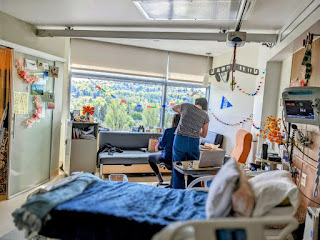A transplant plan is unfolding. With uncertainties and some questions.
But first some housekeeping issues. A third iteration of the Calendar is on the
blog to the right. It’s easy and
intuitive to arrange a visit. Pro tip: could be a great way to watch the opening day
parade from the comfort of Kristina’s hospital room on what could be another
drippy Seattle day. Picture it as a private
suite with views of the crew race finish line.
(I should sell tickets).
But please do visit and use the calendar to make arrangements. It’s quick and easy.
The past few days have been up and down – she’s fighting a rash,
on Thursday her red blood cells and platelets dropped, and she needed another transfusion. Fun fact:
She’s had so many transfusions that her blood type has changed.
She had two surprise biopsies on Thursday as well. Not fun.
In addition, her hair is beginning to fall out. Predictable, she knew it was coming, but
dammit. When it starts to happen, it
sucks. At every turn there’s another
reminder. Strong and bold melts to occasional
self-pity. Yes, there were tears.
Kristina’s discharge date from this round at the hospital will
likely be between May 20th and 24th. As mentioned earlier, her bone marrow test is
on the 24th at which point they’ll measure the blast cell
level. Which now needs to be zero, not
the 5% we’ve talked about for reasons we’ll get into in a bit.
The
conditions for her hospital discharge this time are many, but the key is her ability
to fight infections. And the key to that
is her neutrophil count. What’s a
Neutrophil you ask? They are a type of white blood cell that kills bacteria. Neutrophil cells confront bacteria, ask ‘friend
or foe’, then kill the bad guys (er, bacteria). Picture
them as guardians coursing through your body.
Pretty sure it doesn’t work exactly like that, but you get the point.
The Absolute Neutrophil Count (ANC) …the medical community is a virtual
acronym generator… is an estimate of the body’s ability to fight infections,
particularly bacterial infections. The
ANC measures the number of neutrophils in the blood.
So, what are the counts of these crime fighting cells in the human
body? It varies. (googles, brings up handy chart, see below)
|
Risk of infection
|
ANC value
|
|
Highest
|
Lower than 500
|
|
Moderate
|
500-1,000
|
|
Lower
|
More than 1,000
|
If the ANC value is under 500, the risk of infection is
high. Kristina’s count yesterday was
zero. The result of Chemo. These counts need to rise before Kristina can
be discharged.
So while a general date of discharge is on or about May 20th,
her ‘counts’ need to improve and it’ll be the counts that drive the discharge
date.
Now to the transplant plan.
Two possible donors, both in Europe,
have been identified. Both are 12/12
matches which is about as good as it gets.
The only rub with European based donors is it’s about a week of extra
logistics.
Her first meeting with the transplant team is scheduled for June 6th. But that’s just the opening salvo in the
process. In the two weeks after June 6th,
she’ll be subjected to a battery of tests to ensure she’s in sufficient shape for
the transplant. Is her heart ok? Que the echocardiogram test. Are there any infections in her mouth (there’s
a dental exam specifically for prospective transplant patients). Are her lungs ok. Etc, etc.
There’s a comprehensive panel of
tests in store for Kristina. But wait. There’s more.
‘Across the pond’, somewhere in Europe, the donor will be going through
their own battery of tests, coincident with Kristina.
If all is still going well, Kristina will be admitted back into
the hospital on June 27th. There’s
more treatment, low doses of radiation, that she’ll have to endure before the
transplant.
On or about July 4th, a cancer care alliance volunteer
will fly to Europe. At about the same
time, stem cells are extracted from the donor.
As the plane lands, the stem cells are driven, encased in cold packaging,
to the airport. Somewhere in the terminal,
the exchange is made and the volunteer flies back to Seattle, stem cells in
hand. Or more likely in the overhead
baggage compartment.
Now for the transplant itself.
Kristina’s previous transplants have been ‘conventional’ allogeneic stem
cell transplants. Full transplant. What her doctors are proposing this time is a
‘Non-Myeloablative transplant’. A mini
transplant.
Kristina’s perception of the ‘mini’ transplant isn’t great. She’s seen it used for patients who are not
good candidates for the conventional approach.
The ‘old’, or folks who are terminal but want to make it to their granddaughters
wedding date. Historically it’s been
used more as a temporary band aid to buy a few more months.
Kristina is also under consideration for one of two medical trials
– C-Glam and Flu-mel. The first is a
similar ‘cocktail’ to what she went through 2 weeks ago, the second is a different
chemical cocktail. In either case, she’ll
undergo TBI – total body irradiation, Nothing
is set yet, but Kristina is, candidly, fearful of the irradiation. There may be significant – and long lasting side
effects.
Kristina doesn’t want a bandaid.
She wants to go full throttle, recover and rock and roll for many more
years.
There may be a disconnect between Kristina’s perception of the historical
use of the ‘mini transplant’ and how it is now used. The doctors are saying they have seen good
outcomes from this approach. In
addition, her blast cell count now needs to be zero for this ‘mini transplant’.
Questions remain on this approach.
More dialogue is needed. In the
meantime, use the calendar to the right.
She’d love to see you.

















